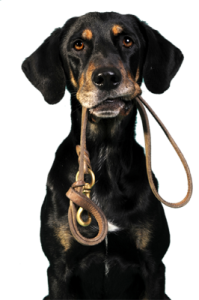
Yesterday, we touched on the necessity of pairing up your dog with the right collar/leash. A good harness or leash can make your job as a responsible pet walker easier. But so too can a well-trained dog. Understandably, however, teaching your dog how to properly behave on a leash is much more time intensive than just picking up a good leash at the pet store.
If you have a young dog or a dog that is not accustomed to being on a leash yet, then start them slowly. Simply attach the leash and let them get used to having it on as they go about their normal day. Make sure they don’t get themselves wrapped around a table leg or tree! After they can wear a leash without trying to squirm out of it, then start with short walks around the house – and remember, rewards work better than punishment. Some dogs take naturally to being on a leash and some don’t, so don’t give up if you have to work at it. They’ll figure it out eventually. Reward them with a treat when they follow you or walk by your side without trying to pull away. Sooner or later, they’ll discover that it pays more to walk along with you without yanking on the leash.
If your dog insists on pulling, then make it a habit to stop the walk every time he/she pulls away. Accompanying this with a sharp “No!” or “Stop!” can help your dog learn that pulling away is not what you want. When the walk starts again and your dog behaves properly on the leash, be sure to reward them with praise and a treat.
The difference between a behaved dog on a leash and one who is willful and disobedient is the difference between night and day. It will make your life so much easier when your dog walks with you instead of over you.
